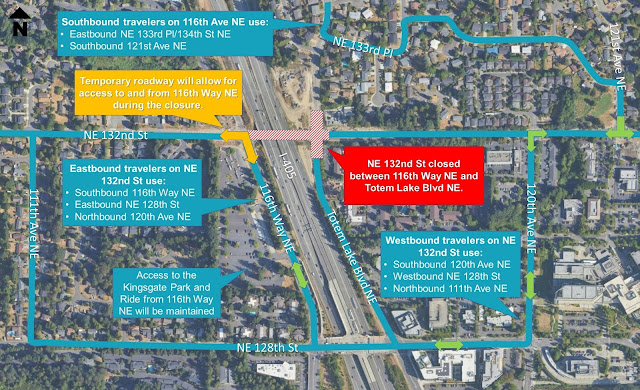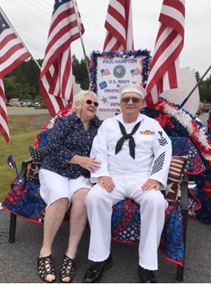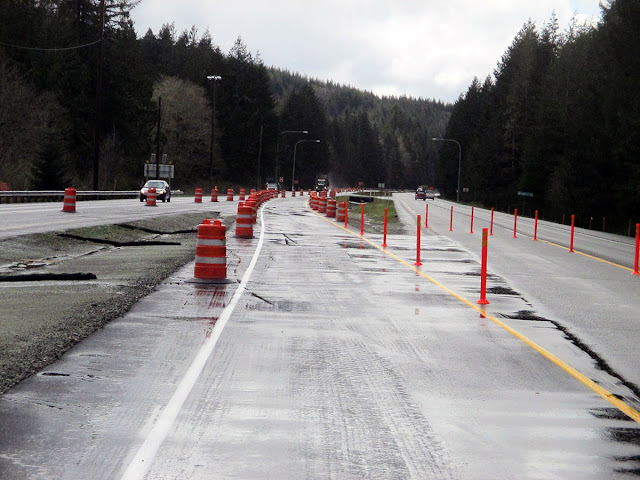UPDATE: 2:07 p.m. Tuesday, Aug. 29
Northeast 132nd Street is scheduled to reopen from its two-week closure on Monday, Sept. 4. Once the street is reopened, there will be a temporary configuration of single-lane roundabouts at each previously signalized intersection. Construction will still be ongoing and the final configuration of multilane roundabouts will be complete this winter. Expect delays and plan extra travel time in the area while construction continues into its final stage. We appreciate your patience.
By Victoria Miller
It’s been a busy summer of construction and while the traffic congestion from construction has been difficult, the good news is that we are making progress on our projects.
In Kirkland, the I-405/NE 132nd St Interchange Project has made significant progress and is scheduled to be open to traffic by the end of this year. As you may know, the project builds a half-diamond interchange with a new northbound on-ramp to Interstate 405 and a new southbound off-ramp from the highway. As part of the project design, the intersections of the new ramps will include roundabouts.
While we have seen roundabouts implemented into several construction projects across the state in the past, this will be the first set of roundabouts in an I-405 interchange as well as the first set of roundabouts in Kirkland.
How do you drive a roundabout?
Roundabouts are designed to make intersections safer and more efficient for drivers, pedestrians, and cyclists. There are two basic types of roundabouts: single-lane and multi-lane. The roundabouts being built for the I-405/NE 132nd St Interchange Project will be multi-lane roundabouts.
There are a few key things to remember about driving through roundabouts:
- Be aware of pedestrians as you enter and exit the roundabout
- Yield to drivers already in the roundabout (on the circulating roadway)
- Stay in your lane; do not change lanes
- Do not stop in the roundabout
- Avoid driving next to oversize vehicles
In a multi-lane roundabout, you will see two signs as you approach the intersection: the same yellow "roundabout ahead" sign and speed signs used for single-lane roundabouts, and a black and white "lane choice" sign. This second sign is to help you choose the appropriate lane for the direction you want to exit the roundabout.
You choose your lane in a multi-lane roundabout the same way you would in a traditional multi-lane intersection. Generally, to go straight or turn right, you would use the right lane. To go straight or turn left, you would use the left lane. Usually, you can also make a U-turn from the left lane as well.
The graphics below show which turns can be made from each lane at the future Northeast 132nd Street roundabouts. Arrows in yellow show movements that can be made from the left lane, and arrows in orange show movements that can be made from the right lane.
After selecting the appropriate lane, yield for pedestrians in the crosswalk as you approach the roundabout. Before entering the roundabout, look to your left and yield to drivers already in the roundabout. It is important to remember that in a multi-lane roundabout, entering traffic must yield to both lanes of the circulating road. If there is no traffic in the roundabout, you may enter without yielding.
When there is a gap in traffic, merge into the roundabout in the correct lane and proceed to your exit. Look for pedestrians and use your turn signal before exiting the roundabout.
Want to learn more? We also have a video available online about how to drive a roundabout .
You can also download our Rules of the Roundabout brochure in English and Spanish (PDF 379KB).
How do pedestrians and cyclists use roundabouts?
Modern roundabouts are designed to be safe for people walking or using mobility assistance devices. Vehicles are moving at a slower rate of speed in roundabouts - typically 15 to 20 miles per hour.
Crosswalks are set farther back from vehicle traffic, allowing more time for drivers to react to people crossing before merging into or exiting the roundabout. Triangular islands between lanes of vehicle traffic provide pedestrians moving through the roundabout a safe place to wait if they choose to cross only one direction of traffic at a time.
People using the crosswalk should look for approaching vehicle traffic, then move through the crosswalk to the triangular island. Before continuing, they should look for traffic entering or exiting the roundabout. When it is safe, they can continue through the crosswalk.
Bicyclists can choose to ride through the roundabout with traffic or walk their bicycles through the pedestrian crosswalks similar to a traditional intersection. Like people driving, bicyclists must obey the rules of the roundabout as they proceed through the intersection. Riders who choose to walk their bicycles may find that some roundabout designs have a ramp onto the sidewalk, making it easier for bicycles to transition from the roadway to the sidewalk.
Want to learn more? Watch a video about using a roundabout as a driver, pedestrian or bicyclist.
What to expect during roundabout construction
To build the roundabouts, there will be an approximately two-week-long closure of Northeast 132nd Street between 116th Way Northeast and Totem Lake Boulevard Northeast. The closure will begin as early as Friday, Aug. 18. There will be no vehicle access to this section of Northeast 132nd Street during the closure and a signed detour will be in place for travelers in the area.
 |
| Detour map for the two-week-long closure of Northeast 132nd Street between 116th Way Northeast and Totem Lake Boulevard Northeast from Friday, Aug. 18 to Monday, Sept. 4. |
Where can I learn more about the project’s construction?
To learn more about the project construction, how to use roundabouts, and additional details regarding detours, the project team is hosting an in-person project update meeting from 6-7:30 p.m. on Wednesday, Aug. 2 at the Kirkland Justice Center, located at 11750 NE 118th St in Kirkland.
If you are unable to attend the project update meeting, you can find more information on the project webpage . If you have additional questions, you can call our construction hotline at 425-224-2433 or email us at i405sr167program@wsdot.wa.gov.
To learn more about roundabouts in general, you can read about the safety performance benefits, traffic flow benefits, and operations on our roundabouts webpage.
Learning how to navigate new traffic configurations can be an adjustment, especially after having to navigate detours from construction. We want to make sure everyone is safely prepared for what’s to come to I-405 in the Totem Lake area. We’re almost there – hang tight and get ready!
























.png)











